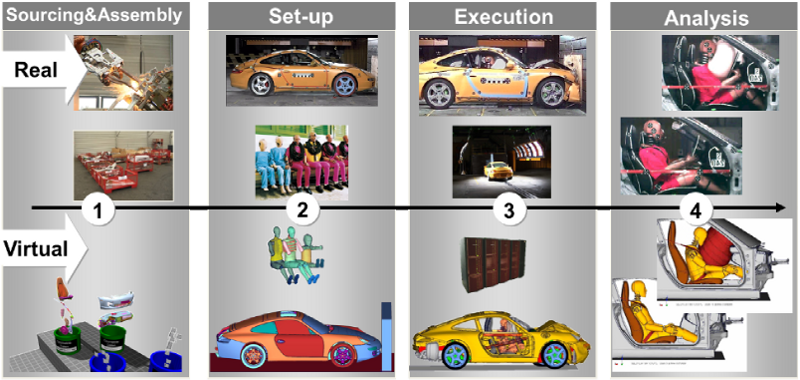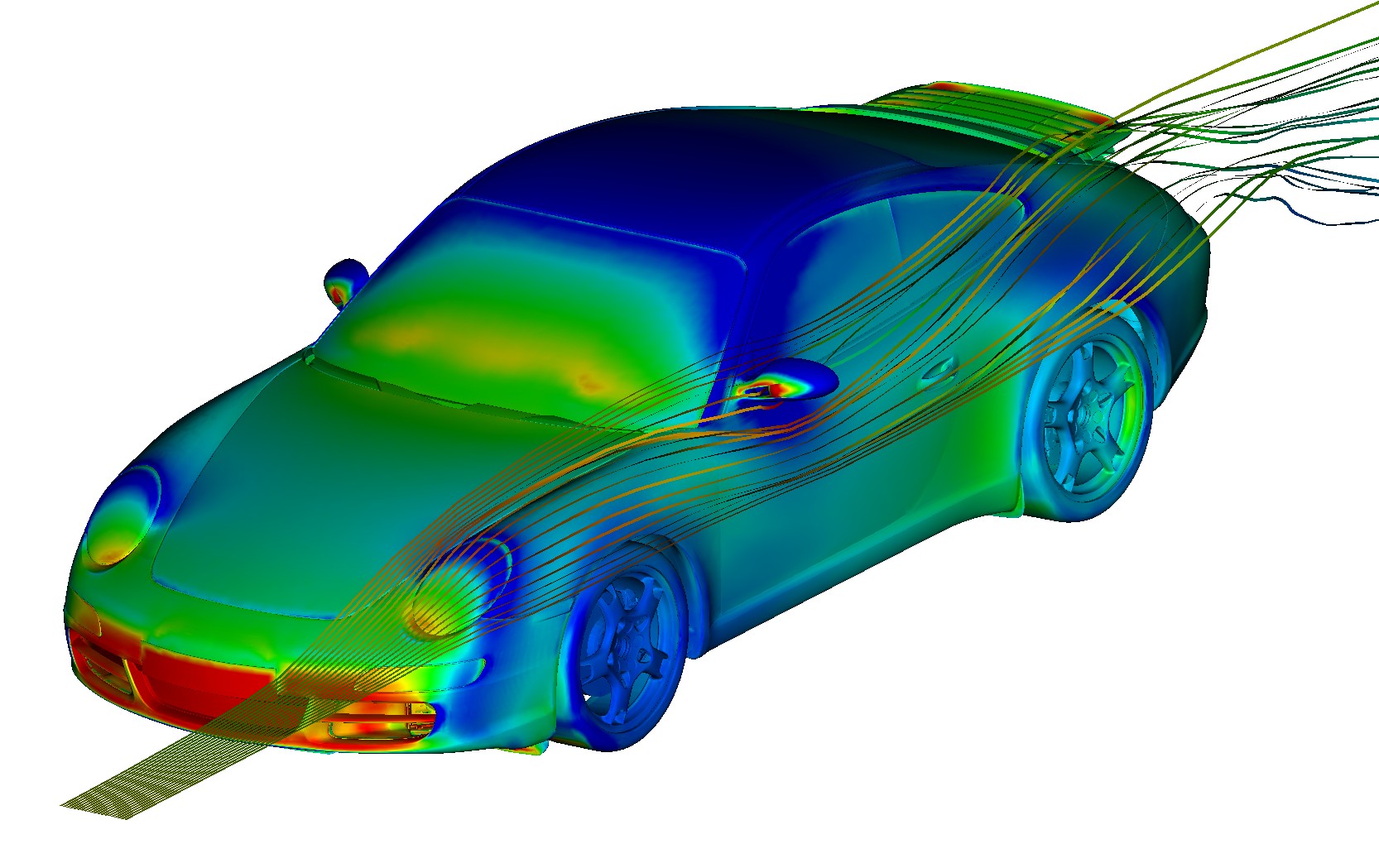Automotive use case
Motivation
With 2.166.000 employees* the automotive industry is one of the key factors for economic growth and prosperity in the European Union. For the development of sustainable vehicle and mobility concepts the continuously increasing digitalization and simulation process is one of the main competitiveness factors. A remarkable shift from design processes based on physical prototypes to a computationally aided development process based on virtual prototypes is recognizable for the last couple of years.

Fig 1: Real versus virtual crash testing (source: Dürheimer, Porsche AG, 2008)
Nevertheless, the very fast growing global competitive pressure and new legal regulations (stricter guidelines for personnel leasing) during the last few years lead to a complete rethink of Computer Aided Engineering - CAE and High Performance Computing – HPC processes. It is now a question of going further to flexible and easy to access / operate CAE work environments. Therefore cloud computing could be an opportunity for the overall European automotive, aerospace and engineering industry, especially for innovative small and medium enterprises – SMEs (e.g. suppliers, engineering service providers and independent software vendors). Their budget for CAE hard- and software is limited, but car manufacturers generally dictate which CAE software must be used by their suppliers. Different software applications have different requirements in term of computing time and data volume. It is easy to understand that these significant variations in customer projects and the additional fluctuation in the order situation create the necessity of new flexible CAE work environments to remain competitive.
The CAE use case in PaaSage exactly addresses this future-oriented CAE work environment based on cloud computing. It should be shown, that cloud computing fulfills the demands, which companies and SMEs place on modern CAE workflows. For a flexible and easy to operate CAE work environment it is important to have the flexibility to change the cloud service provider according to the best price model, the best technical infrastructure and the best support. The technical hurdles for a cloud platform change should be minimized as much as possible.
The benefit of the CAE use case for PaaSage is the integration of an extremely broad CAE end user group (automotive, aerospace, engineering, consumer goods industry). This will guarantee the necessary attention to bring the developments of PaaSage into the European industry.
* Source: http://de.wikipedia.org/wiki/Automobilindustrie
CAE work flow
Especially in the concept phase of a vehicle development process, the most concept relevant decisions are made on the basis of simulation results. The typical CAE workflow for the virtual car development process is illustrated in Figure 2. In PaaSage a Computational Fluid Dynamics – CFD work flow of a side mirror serve as sample CAE application with high demand on computing power. Up to now high performance computing clusters were used to solve this problem. In future the use of cloud computing can lead to a flexible and easy to access / operate CAE work environment. The classical CAE workflow is characterized by three steps:

Fig 2: The typical CAE workflow for the virtual car development process
Pre-processing: Starting with the preparation of a CAD (computer aided design) model, everything needs to be transferred into a CAE model. Therefore the physical space has to be discretized into a mesh-grid domain and set up with the respective boundary conditions.
Simulation: As soon as the pre-processing phase is completed, the simulation starts. CAE can’t be performed on simple workstations but need to be carried out on HPC clusters or (in future) on clouds. Especially for clouds the transmission of the very large CAE models and simulation results (data volumes in the range of Gigabyte) leads to high requirements for a stable process and work flow. Therefore very powerful networks are required. Besides a very fast network between the used processors or virtual machines (VMs), the performance of the processors or virtual machines among themselves has to be comparable; otherwise the slow processors or VMs impede the fast ones. The memory requirements for such CAE simulations are also extremely high (approx. 24 – 36 Gigabyte/processor or VM). The handling of such processes on cloud will be shown with the CAE use case.
Post-processing: Finally the simulation results are analyzed and evaluated. This could be done on a local machine, on high performance cluster or alternatively on cloud (should be tested in PaaSage). Visualization tools are used to discuss the output amongst several institutions. Thus simulation experts sit together with test and design engineers and people from the package or management. Together they decide on possible or necessary changes with regard to e.g. design, wall thickness, materials, package or cost aspects etc. Afterwards another iterations start, beginning either with changes in the pre-processing phase or even with a modification of the CAD model data.
CFD application – side mirror calculation
An exemplary automotive use case is the development of a side mirror. Along the supply chain different companies and SMEs with different soft- and hardware facilities are involved in the virtual development process. The use case will show how products can be developed through a flexible and easy to access / operate CAE cloud environment. Each of the virtual development steps (Pre-processing, Simulation, Post-processing) will be tested on a Private Cloud (e.g. GWDG-Testbed). Therefore beginning from a simulation performed on a HPC cluster (e.g. HLRS) the reallocation of the results to a private CLOUD will be tested. The migration of the Visualization tools and Visualization of results in the CLOUD from different local facilities will be considered within this use case. Finally high performance criteria as Scalability will be studied and tested using PaaSage

Fig 3: A side mirror of a car

